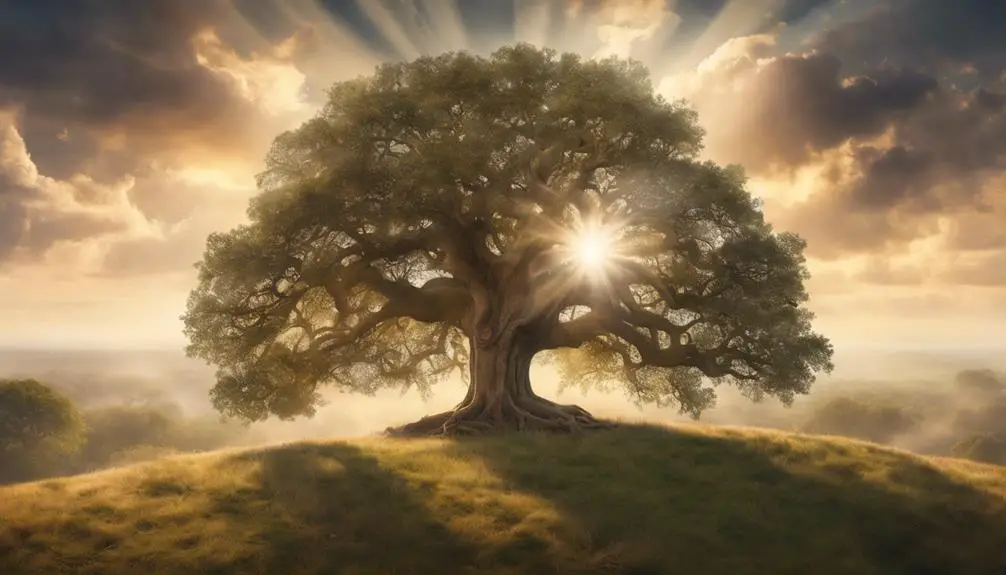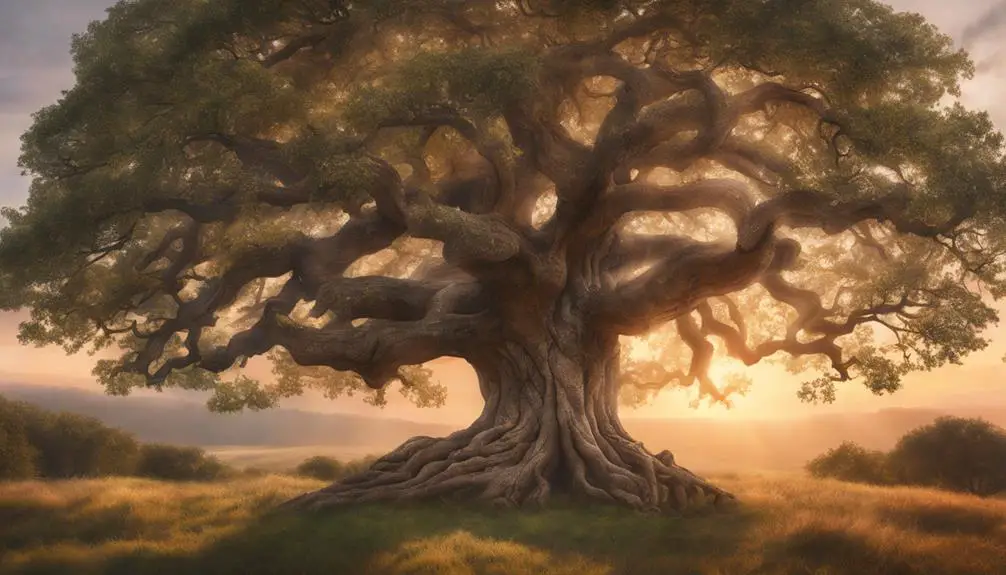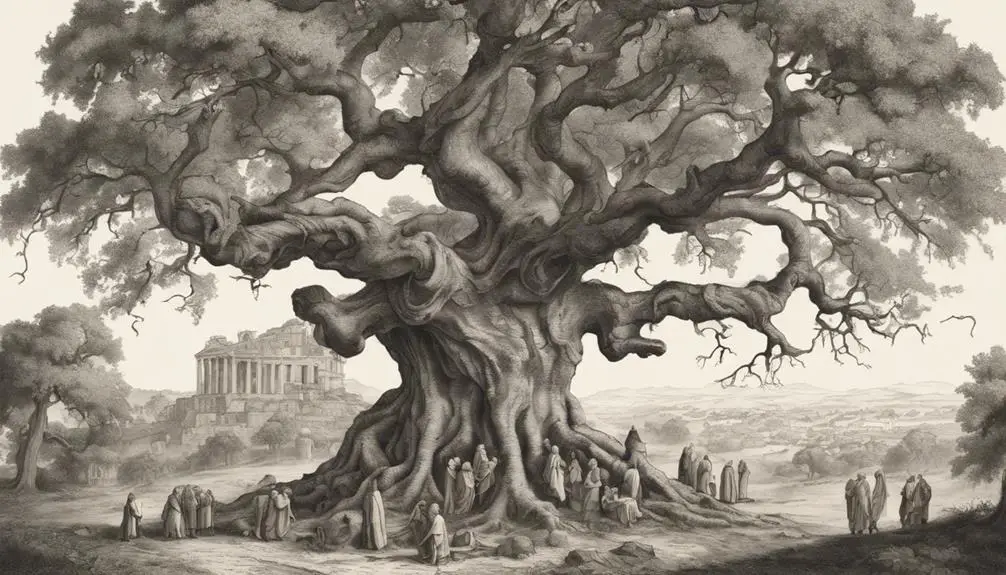Discover how oak trees symbolize strength and sacredness in biblical narratives, shaping key historical and spiritual events.

Oak Tree Meaning in the Bible
Did you know that oak trees are mentioned over 20 times in the Bible?
This isn't just a case of frequent flora appearances; it's a testament to the deep symbolism and significance these trees hold in biblical narratives.
You're about to uncover why the oak stands as a symbol of strength and endurance and how it has served as a sacred space through historical events within the scriptures.
From metaphorical uses to divine associations, the oak tree carries a richness that might just transform your understanding of certain biblical passages.
Let's explore what makes these mentions more than mere references to nature.
Key Takeaways
- Oak trees in the Bible symbolize strength, resilience, and steadfast faith in adversity.
- They are associated with sacred spaces, divine encounters, and covenantal promises.
- Their growth and life cycles metaphorically reflect spiritual maturation and hope for renewal.
- Oaks serve as historical markers and cultural symbols in biblical narratives and practices.
Symbolism of Strength and Endurance

In biblical texts, the oak tree embodies strength and endurance, serving as a powerful metaphor for resilience and steadfastness in the face of adversity. This symbolism is deeply rooted in the tree's natural characteristics, particularly its growth cycles and leaf symbolism, which are reflective of spiritual and physical renewal. The oak's slow yet steady growth cycle mirrors the patience and perseverance required to maintain faith during challenging times. As it weathers seasons and storms to reach impressive heights and spans, so too are believers encouraged to stand firm in their convictions.
The deciduous nature of the oak, shedding its leaves in autumn and rebirthing in spring, further deepens its symbolic significance. Leaf symbolism in this context represents life's cyclical nature, suggesting that periods of loss and barrenness are followed by renewal and growth. This cycle echoes the biblical themes of resurrection and hope, illustrating that through faith, one can emerge stronger from trials.
Researchers like Howard (2014) have noted that the endurance of the oak, capable of living for hundreds of years, symbolizes the eternal nature of spiritual truths, transcending temporal struggles. Thus, the oak tree's symbolism in the Bible encapsulates a profound message of resilience, renewal, and the enduring strength of faith.
Oak Trees as Sacred Spaces
Beyond their symbolic representation of strength and endurance, oak trees have also served as sacred spaces within biblical narratives, offering unique settings for spiritual encounters and worship. The presence of these majestic trees in sacred texts isn't merely for scenic imagery but underscores their role in facilitating divine connections.
- Centers of Divine Encounters: Oak trees often provided the backdrop for pivotal moments of divine communication and revelation, serving as physical markers of spiritual significance.
- Symbols of Ancestral Worship: References to oak trees in the context of ancient practices suggest their importance in rituals, possibly hinting at a broader tradition of tree worship among early communities.
- Locations for Sacred Rituals: Specific narratives recount the use of oak groves as venues for sacred rituals, emphasizing the tree's role in hosting ceremonies that were central to spiritual life.
- Gathering Points for Worship: These trees weren't only individual markers but also communal spaces, where groups gathered for worship, highlighting the oak's role in fostering communal spiritual experiences.
Analyzing these aspects within the biblical context reveals a rich tapestry of meanings, pointing to the multifaceted role of oak trees in spiritual narratives and their importance beyond mere physical presence.
Historical Significance in Biblical Events

Reflecting on their role in spiritual narratives, oak trees also stand tall in the annals of biblical events, marking moments of historical significance with an enduring legacy. These majestic trees aren't simply part of the landscape; they're woven into the very fabric of biblical history, serving as silent witnesses to pivotal moments and cultural practices of ancient times.
Considering their geographic distribution, oak trees predominated in areas that are now modern-day Israel and surrounding regions, placing them at the heart of numerous biblical stories. Their presence underscores the connection between the physical environment and the unfolding of historical events, illustrating how geography and natural resources shaped cultural practices. For instance, the oak's strength and longevity likely contributed to its symbolic significance in ceremonies and as markers for important sites and meetings.
Scholarly analysis reveals that oak trees were more than just part of the scenery; they played a crucial role in the daily lives and spiritual practices of the people. Through their integration into these events, oaks contributed to the rich tapestry of biblical narratives, offering a unique perspective on the interaction between humanity and the divine within a specific geographical and cultural context.
Metaphorical Use in Scripture
Analyzing scriptural texts reveals that oak trees often serve as powerful metaphors, symbolizing strength, endurance, and spiritual resilience in the biblical narrative. This metaphorical usage isn't merely decorative but deeply woven into the fabric of spiritual messages, offering believers insights into their own journey of faith.
Here are some aspects of how oak trees are metaphorically used in Scripture:
- Symbol of Steadfast Faith: Just as oak trees stand firm against storms, they represent unwavering faith amidst life's tumultuous challenges, encouraging believers to stand firm in their beliefs.
- Emblem of Righteousness: The robustness and longevity of oaks symbolize the enduring nature of righteousness in a believer's life, serving as a reminder of the rewards of living a life aligned with divine principles.
- Representation of Spiritual Growth: The gradual, sturdy growth of an oak mirrors the believer's spiritual maturation process, emphasizing patience, persistence, and the cumulative nature of small, daily acts of faith.
- Renewal Imagery: The life cycle of oak trees, including periods of dormancy and vibrant regrowth, provides potent renewal imagery, symbolizing hope, rebirth, and the possibility of spiritual revival and transformation.
These metaphorical uses enrich the text, offering layered meanings that underscore themes of spiritual growth and resilience.
Oaks and Their Divine Associations

In the biblical context, oak trees aren't only metaphors for spiritual qualities but also hold divine associations, suggesting a deeper, sacred connection to God's presence and actions in the world. These towering entities serve as spiritual markers, anchoring significant events and divine encounters within the scriptural narrative.
For instance, Abraham's establishment of an altar by the oaks of Mamre (Genesis 12:6-7) underscores the oak's role as a witness to covenantal promises and divine revelation. This location becomes a recurrent scene for divine-human interaction, illustrating how oaks aren't mere backdrop but participants in the unfolding of God's plan.
Moreover, the Prophet Isaiah's reference to oaks in Isaiah 61:3, as symbols of strength and righteousness given by God to His people, further cements the oak's association with divine attributes and blessings. These instances reflect a pattern where oaks are imbued with a sacredness, marking them as sites of divine encounters and spiritual renewal.
Consequently, the presence of oaks in biblical narratives isn't incidental but deeply intentional, signaling moments of divine intervention and the establishment of holy remembrance throughout the land.
Frequently Asked Questions
How Do Different Translations of the Bible Vary in Their Depiction of Oak Trees?
Different Bible translations vary in depicting oak trees due to translation methodologies and linguistic evolution.
You'll find that earlier translations might stick closer to literal interpretations, while modern versions often aim for conceptual clarity, considering the cultural and linguistic shifts over time.
This divergence reflects scholarly debates on fidelity versus transparency in translation, impacting how these natural symbols are presented across versions, from the King James to the New International Version.
Are There Specific Types of Oak Trees Mentioned in the Bible, and Do They Correlate to Species Known Today?
In your quest for knowledge, you're pondering if the Bible specifies types of oak trees, correlating with modern species. While it doesn't dive into oak genetics or climate adaptation, the ancient text mentions oaks in a general sense, leaving specific species identification to scholarly interpretation.
This gap in direct correlation challenges researchers to bridge ancient descriptions with contemporary oak species, blending theological study with botany to enrich our understanding of these sacred texts.
How Have Cultural Perceptions of Oak Trees Outside of Biblical Contexts Influenced Their Interpretation Within Scripture?
Your understanding of oak trees in scripture is shaped by ancient myths and cultural rituals outside the Bible. These elements weave together, influencing how you interpret their symbolic meaning within biblical texts.
By examining how societies have revered oak trees for their strength and longevity, you gain insights into why these trees hold significant spiritual symbolism in religious texts.
This analysis reveals the deep interconnection between cultural perceptions and scriptural interpretations.
What Role Do Oak Trees Play in Modern Christian Practices and Symbolism?
You might think oak trees are just background in modern Christian practices, but they're central to many.
Oak ceremonies, including blessings and gatherings around these majestic trees, symbolize strength and endurance. As worship locations, oaks offer a natural sanctuary, reflecting a bridge between creation and Creator.
This intertwining of nature and faith demonstrates oak trees' enduring symbolism, deeply rooted in tradition yet adapting to contemporary expressions of spirituality.
Can the Mention of Oak Trees in the Bible Be Connected to Environmental Stewardship or Creation Care Teachings Within Christianity?
Certainly, you can link the mention of trees in ancient texts to contemporary teachings on environmental stewardship within Christianity. By examining ancient agriculture practices and modern reforestation efforts, it's clear that caring for creation aligns with these teachings.
This perspective encourages Christians to view environmental care as a fundamental aspect of their faith, drawing inspiration from historical practices to inform current actions toward sustaining and nurturing the planet.
Conclusion
In your journey through the sacred texts, you've traced the roots of the oak's symbolism, from its embodiment of resilience to its role as a divine meeting spot.
These ancient sentinels, draped in historical and metaphorical significance, offer a leafy testament to faith's endurance (Jeremiah 17:8). Their presence whispers of strength and sanctity, serving as a beacon for those seeking solace under their sprawling canopies.
Thus, the oak stands not just as a botanical marvel but as a profound emblem of spiritual steadfastness and divine grace.



Sign up